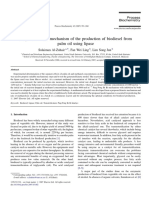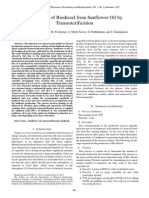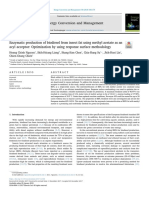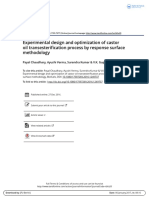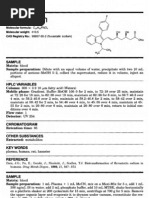Non-Alcohol Route of Biodiesel Synthesis From Used Cooking Oil Using Immobilized Biocatalyst in Packed Bed Reactor
Non-Alcohol Route of Biodiesel Synthesis From Used Cooking Oil Using Immobilized Biocatalyst in Packed Bed Reactor
Uploaded by
Heri HermansyahCopyright:
Available Formats
Non-Alcohol Route of Biodiesel Synthesis From Used Cooking Oil Using Immobilized Biocatalyst in Packed Bed Reactor
Non-Alcohol Route of Biodiesel Synthesis From Used Cooking Oil Using Immobilized Biocatalyst in Packed Bed Reactor
Uploaded by
Heri HermansyahOriginal Title
Copyright
Available Formats
Share this document
Did you find this document useful?
Is this content inappropriate?
Copyright:
Available Formats
Non-Alcohol Route of Biodiesel Synthesis From Used Cooking Oil Using Immobilized Biocatalyst in Packed Bed Reactor
Non-Alcohol Route of Biodiesel Synthesis From Used Cooking Oil Using Immobilized Biocatalyst in Packed Bed Reactor
Uploaded by
Heri HermansyahCopyright:
Available Formats
Journal of Sustainable Energy & Environment 2 (2011) 1-5
Non-Alcohol Route of Biodiesel Synthesis from Used Cooking Oil Using Immobilized Biocatalyst in Packed Bed Reactor
H. Hermansyah*, R. Arbianti, D.A. Prameshwari
Department of Chemical Engineering, Faculty of Engineering, University of Indonesia, Depok 16424, Indonesia *Corresponding author: heri@che.ui.ac.id
Abstract: Immobilized Candida rugosa lipase acts as a biocatalyst for interesterification of used cooking oil with methyl acetate in a packed bed reactor. Reactants and products are analyzed using HPLC, and the effect of residence time and operational stability are also investigated. The results indicate that this biocatalyst can convert 71.5% fatty acid from triglyceride in used palm oil for 5.5 h of residence time. Stability test results show that the immobilized biocatalyst retains good activity for 50 hours without appreciable loss in substrate conversion. The largest conversion obtained from this study was 87.09%, achieved during the stability testing under optimum operating conditions. Furthermore, the kinetic models based on the Ping Pong Bi Bi mechanism are applied to the experimental data to describe the reaction behavior. The fitted results show that the Model C gave the smallest error and fairly described the reaction behavior. Keywords: Biodiesel, used cooking oil, candida rugosa lipase, interesterifcation, non-alcohol route, kinetics.
1.
Introduction
The increase in the price of fuel oil, a significant factor in the world energy crisis, has forced Indonesia to explore alternative and undeveloped sources of fuel. Sources of energy derived from oil will diminish with increased consumption of fuel, especially diesel. Therefore, alternative fuel is required to overcome the problems associated with decreasing non-renewable energy sources [1]. Biodiesel is an alternative fuel made from vegetable oils and animal oil that comes from renewable sources. Raw material for producing biodiesel includes palm oil (CPO), soybeans, sunflowers, and other plants [2]. Although CPO is the better prospect to be processed into biodiesel, its price as a raw material for biodiesel has been increasing, along with the oils scarcity. Fortunately, waste cooking oil offers promising potential as an alternative raw material for biodiesel [3]. Conventionally, biodiesel is produced by transesterification of triglycerides with methanol using an alkali catalyst [4]. However, the use of an alkali catalyst in the synthesis of biodiesel can cause some problems. For example, the alkali catalyst has the potential to mix homogeneously with the product, so that the process of purifying the products becomes relatively difficult. In addition, the alkali catalyst may cause undesirable side reactions, such as saponification, which burdens the purification process and decreases conversion of biodiesel. To overcome these obstacles, a heterogeneous catalyst that can direct specific reactions is needed. Research about lipase as a biocatalyst for the synthesis of biodiesel is continuously developing to repair the weaknesses of the alkali catalyst. Lipase as a biocatalyst can direct a reaction specifically [5]. However, excess alcohol leads to inactivation of the enzyme [4]. In 2004, Du et al. conducted research regarding the synthesis of biodiesel using metil acetate to replace methanol as the acyl acceptor, and the product produced during interesterification had no negative effect on lipase activity [4]. Weaknesses of lipase as the catalyst, however include its expensive pricetag and the tendency of the enzyme to dissolve in liquid media. Since it is very difficult to separate lipase from the product produced, an immobilized enzyme technique has been developed. The enzyme is added to and trapped in a support and cannot be mixed with the reaction solvent [6]. This technique permits the enzyme to be used repeatedly, offering a method for cutting the production
cost of biodiesel, which is relatively expensive if the enzyme is used as a homogeneous catalyst. Although lipase as a biocatalyst provides advantages in the synthesis of biodiesel, industry remains slow to capitalize on its application. For wider use in industry, the biodiesel synthesis using lipase must become more feasible both technically and economically. A possible solution is the use of the packed bed reactor (PBR) because [7]: 1. The possibility of a repeated use of immobilized biocatalyst in PBR 2. It is suitable for use in long and large scale production. 3. Production is more cost-effective for the PBR than the batch reactor. 4. Using a PBR instead of a batch reactor lowers the ratio between the substrate with the enzyme. Xu et al. argue that replacing alcohol with alkyl acetate may produce side products, triacetylglycerol, which are more marketable than glycerol [8]. It can therefore be assumed that the synthesis of biodiesel via non-alcohol routes promotes profitability. Concurrently, lowering production costs of biodiesel while increasing stability of the biocatalyst requires employing the immobilization method to trap lipase in support. Contemporary research, therefore, must focus on the synthesis of biodiesel via the non-alcohol route using immobilized biocatalysts on continuous reactors. The purpose of this research is to identify the optimum operating condition for the biodiesel synthesis from used cooking oil using immobilized lipase as biocatalyst through non-alcohol route. The goals of this study are to determine the flow rate of substrate needed to produce an optimal biodiesel conversion and the type of oil best suited to produce an optimal conversion in the synthesis of biodiesel, and to investigate the stability of Candida rugosa lipase as a biocatalyst for a packed-bed reactor system. In addition, enzymatic modeling (uniresponse modeling) facilitates analysis of the relationship between residence time and the conversion of biodiesel. 2. Experimental 2.1 Biocatalyst Immobilization Experiment The lipase solution was prepared by adding 0.4 grams of powder lipase to 40 mL of phosphate buffer solution. 1 mL of the
Copyright @ 2011 By Journal of Sustainable Energy and Environment
Journal of Sustainable Energy & Environment 2 (2011) 1-5
Figure 1. Schematic diagram of continuous reactor for interesterification. lipase solution was taken to measure the initial enzyme concentration using an ultraviolet (UV) spectrophotometer. 6.51 grams of prepared zeolite were then inserted into the solution and mixed for 4 hours. Finally, the zeolite was separated from the solution and dried prior to use. 2.2 Synthesis of Biodiesel at Packed Bed Reactor with Flow Rate Variation The reaction took place in a packed bed reactor (PBR), in which zeolite was brought into the reactor up to full. Substrate was uniformly mixed in the glass beaker so that the molar ratio of used palm oil to methyl acetate was 1:12. Substrate was then inserted into the syringe and transferred using a syringe pump with a specific flow rate. Before the reaction began, the reactor (Fig. 1) was heated to 37C. To ensure that lipase, as the biocatalyst, had reached optimum temperature during the synthesis process. This experiment was conducted with 4 variations of flow rates: 1 mL/hr, 2 mL/hr, 4 mL/hr, and 5 mL/hr. Residence time was noted for each flow rate. Concentration of biodiesel produced was analyzed using High Performance Liquid Chromatography (HPLC). 2.3 Stability Test for Immobilized Biocatalyst Five types of used cooking oil were utilized in this experiment to assess their stability levels in the synthesis of biodiesel using immobilized biocatalysts in a packed bed reactor (PBR). Immobilized biocatalysts were brought into the reactor until full. The molar ratio of used cooking oil to methyl acetate was 1:12. The stability test was carried out continuously for 50 hours, with a sampling process conducted at t (hours): 0, 3, 6, 9, 12, 15, 20, 25, 30, 40, and 50. Concentrations of biodiesel produced were analyzed using HPLC. 2.4 Enzymatic Reaction Modeling: Uniresponse Flow rate variation experiments were conducted to examine the influence of residence time on the total concentration of biodiesel produced. Three Malcata`s models of interesterification reaction were proposed [9]: (1) rint, A = A1 [G ] Model A (Eq.1) and Model B (Eq. 2) represent the interesterification reaction model that refers to the Ping Pong Bi Bi mechanism, which assumes acylation and deacylation to be the rate limiting reaction. Model C (Eq. 3) in original form is not simplified. All three models were adjusted for experimental data using numerical methods. One numerical method used is the RungeKutta-Felburg Order 4 [10]. The trial and error method predicts the unknown parameters for the best fitting for the three models. The parameter requiring adjustment for all models is , the lump parameter. 3. Results and Discussion 3.1 Effect of Residence Time This investigation explores the relationship of residence time with the resulting biodiesel conversion as shown in Figure 2. Results of the experiment demonstrate that optimum flow rate can be obtained in the synthesis of biodiesel from used palm oil using an immobilized biocatalyst in a packed bed reactor.
Figure 2. Comparison of biodiesel conversion produced from variance in residence time. Highest biodiesel conversion of 71.47% is obtained at flow rate of 1 mL/hr or residence time of 5 hours, and the lowest conversion (38.79%) is obtained at the largest flow rate (5 mL/hr) and residence time of 1 hour. Findings indicate that a large flow rate creates substantial friction between the substrate and the biocatalyst. The bond formed by immobilizing lipase on
rint, B =
rint,C
B1 [G ] 1 + B 2 [G ] C1 [G ] = 1 + C 2 [G ] + C 3 [G ] 2
(2) (3)
where [G] is glyceride concentration
Copyright @ 2011 By Journal of Sustainable Energy and Environment
Journal of Sustainable Energy & Environment 2 (2011) 1-5
zeolite using the physical adsorption method is relatively weak, so that the flow rate must be arranged not too powerful to prevent desorption/separation of the lipase from the zeolite during reaction [11]. The Concentration of each component in the variation of residence times using immobilized biocatalyst is shown in Figure 3. It is noted that the longer residence time, the higher the concentration of biodiesel produced, indicating that prolonged contact between the substrate and biocatalyst creates a stronger catalytic reaction.
during the reaction. The dramatic curve in Figure 5 indicates that at the beginning of a reaction, the rate of product formation increases significantly. From the concentration profiles, it is noted that the greatest increase in concentration occurs at t=6 hours with a concentration value of 0.0501 mole/L. When the curve has followed the zero-order reaction, the reaction rate has reached maximum speed, so an increasing e rate of product formation will not progress significantly beyond this point. A small increase in the concentration of biodiesel from 5-25 hrs is observed, and after 25 hrs, the stability of the biocatalyst decreases. Another observation is that the concentration of mono-oleic intermediates, remains relatively low throughout the reactions. This is explicable because the intermediate substance does not accumulate but returns immediately and reacts to form a new substance, namely triasetilgliserol.
Figure 3. Concentration of each component in the variation of residence times using immobilized biocatalyst, adsorption method (operating conditions: substrate mole ratio = 1:12, flow rate = 1 mL/hr, 2 mL/hr, 4 mL/hr, and 5 mL/hr; t = 50 hours, and T = 37C). 3.2 Stability Test for Immobilized Biocatalyst The main problems that can arise from the use of a biocatalyst involve deactivation. An immobilized biocatalyst can be used repeatedly, but it would be deactivated finally. Stability operations refer to the catalytic duration of a biocatalyst in continuous operations. Stability operations of a biocatalyst are estimated at half of the duration of use [12], representing a very important parameter for achieving economic feasibility. Our experiment employed a stability test for the biocatalysts, which were immobilized using the adsorption method. The stability test referred to in this experiment is the repeated use of the immobilized enzymes for some reaction cycles continuously. The stability test was carried out continuously for 50 hours to determine the operational stability of the immobilized lipase adsorption method as a biocatalyst in the synthesis of biodiesel. Reactions were observed using five kinds of used cooking oil as substrates, at optimal conditions as shown in Figure. 4. The concentration profiles of Methyl oleic (biodiesel) using immobilized biocatalyst for five kinds of used cooking oil as substrate was shown. The used palm oil gave the highest concentration profiles of biodiesel. The largest conversion obtained from this study was 87.09%, achieved during the stability testing under optimum operating conditions (T = 37C, moles substrate ratio = 1: 12, flow rate of substrate = 2 mL/hr, using used palm oil as a substrate, 50 hours reaction). In Figure 5, concentration profiles of each component in the variation of time from used palm oil as substrate using immobilized biocatalyst were shown. The trioleic concentration (mole/L), is obtained decline trends. Trioleic concentration showed that there is a rate of formation reaction of product Figure 4. Methyl oleic concentration (biodiesel) using immobilized biocatalyst for five kinds of used cooking oil as substrate (operating condition: moles substrate ration = 1:12, flow rate = 2 mL/hr, t = 50 hr, and T = 37C).
Figure 5. Concentration profiles of each component in the variation of time from used palm oil as substrate using immobilized biocatalyst (operating condition: moles substrate ratio = 1:12, flow rate = 2 mL/hr, t = 50 hr, and T = 37C). 3.3 Enzymatic Reaction Modeling Initially, the Felburg Runge-Kutta Order 4 numerical method was used to obtain the concentration of biodiesel for each residence time. The increment used in this method is 0.1 hours, with a residence time range of 0 to 5.5 hours. Value y (0) is the
Copyright @ 2011 By Journal of Sustainable Energy and Environment
Journal of Sustainable Energy & Environment 2 (2011) 1-5
initial concentration of glyceride bonds that can react in the interesterification reaction. By following mass balance, the initial concentration of glyceride bonds that can react is written as: (4) [G ]0 = 3[TG ] + 2[ DG ] + [ MG ] + [ F ] where [G] o is initial glyceride concentration. The value of y (t) is calculated using the Runge-Kutta-Felburg Method. Value y (t) is the concentration of glyceride bonds that does not react (fatty acid residue). The concentration of biodiesel is plotted against residence time, where the concentration of biodiesel is a reduction between the initial concentration of glyceride bonds that can react with glyceride bonds that do not react: (5) [ B] = [G ]0 [G ] where [B] is biodiesel concentration. The fitting results of the three models were shown in Figure 6 for biodiesel concentrations and in Figure 7 for concentration of glycerides bonds that do not react. Figure 6 indicates that the maximum concentration of biodiesel is produced at 5.5 hours, the largest residence time, confirming that prolonged contact between the substrate and biocatalyst increases the probability that lipase will catalyze the reaction. Model C gave the lowest error of the fitted results as shown in Table 1. Thus, the Model C, which is represented complete mechanism of Ping Pong Bi Bi mechanism, can be considered as the best model that can fairly describe the reaction behavior with the Ping Pong Bi Bi mechanism.
Tab1e 1. Parameter values and errors for Models A, B, and C. Error is the square of the difference between the model and the experimental data.
Model A B C Parameter Value () A1 = -0.086 B1 = -0.086 B2 = -0.7 C1 = -0.1 C2 = -0.09 C3 = -0.0001 Total Error 1.5306 x 10-4 1.4152 x 10-4 1.2631 x 10-4
4. Conclusion The largest conversion obtained from this study was 87.09%, achieved during the stability testing under optimum operating conditions (T = 37C, moles substrate ratio = 1: 12, flow rate of substrate = 2 mL/hr, using used palm oil as a substrate, 50 hours reaction). After steady conditions, biocatalyst stability began to decrease. The immobilized biocatalyst used in each experiment retained good stability in operations until 40 hours. After that, the biocatalyst was deactivated. Reduced stability due to the weakening of bonds between the biocatalyst and support was subsequently observed, and lipase became unstable and saturated for binding the substrate. We also observed that a longer residence time increased the concentration of biodiesel produced. The fitted results show that the Model C gave the smallest error and fairly described the reaction behavior. References Tahar, Adrisman., 2005, Kajian Kebijakan dan Kumpulan Artikel Penelitian Biodiesel, Bogor: Institut Pertanian Bogor. [2] Knothe G, Dunn RO, Bagby MO, Biodiesel: The Use of Vegetable Oils and Their Derivatives as Alternative Diesel Fuels Oil Research, Fuels and Chemicals from Biomass 10 (1997) 172208, Washington, D.C., American Chemical Society. [3] Satria, Beni., Minyak Jelantah: Sumber Energi Ramah Lingkungan, http://ganto-online.com. Accessed on 28th May 2008. [4] Xu Y, Du W, Liu D, Study on the Kinetics of Enzymatic Interesterification of Triglycerides for Biodiesel Production with Methyl Acetate as the Acyl Acceptor, Journal of Molecular Catalysis B: Enzymatic 32 (2005) 241-245. [5] Vicente, Biodiesel Production VIA Esterification Reaction by Lipase, http://www.laar.uns.edu.ar. Accessed on 10th April 2008. [6] DSouza SF, Immobilized Enzymes in Bioprocess, Style sheet. www.ias.ac.in, Accessed on 20th April 2008. [7] Watanabe Y, Shimada Y, Sugihara A, Noda H, Fukuda H, Tominaga Y, Continuous Production of Biodiesel Fuel from Vegetable Oil Using Immobilized Candida Antarctica Lipase, Journal of the American Oil Chemists Society 77 (2000) 355-360. [8] Xu Y, Du W, Liu D, Zeng J, Comparative Study on Lipase-Catalyzed Transformation of Soybean Oil for Biodiesel Production with Different Acyl Acceptors, Journal of Molecular Catalysis B: Enzymatic 30 (2004) 125-129. [9] Torres CF, Hill CG, Otero C, Lipase catalyzed Etanolysis of Borage Oil: A Kinetic Study, Biotechnol Prog. 20 (2004) 756-763. [10] Hoffman JD, Numerical Method for Engineers and Scientists (1992) New York: Marcel Dekker, Inc. [11] Hama S, Yamaji H, Fukumizu T, Numata T, Tamalampudi S, Kondo A, Noda H, Fukuda H, Biodiesel Fuel Production in a Packed Bed Reactor Using Lipase-Producing Rhizopus [1]
Figure 6. Fitting results of the three models for biodiesel concentration.
Figure 7. Fitting results of the three models for concentration of glycerides bonds that do not react.
Copyright @ 2011 By Journal of Sustainable Energy and Environment
Journal of Sustainable Energy & Environment 2 (2011) 1-5
Oryzae Cells Immobilized within Biomass Support Particles, Biochem. Eng. J. 34 (2007) 273-278.
[12] Murty VRC, Bhat J, Muniswaran PKA, Hydrolysis of Oils by Using Immobilized Lipase Enzyme: A Review, Biotechnol. Bioprocess Eng. 7 (2002) 57-66.
Copyright @ 2011 By Journal of Sustainable Energy and Environment
Journal of Sustainable Energy & Environment 2 (2011) 1-5
7
Copyright @ 2011 By Journal of Sustainable Energy and Environment
You might also like
- 19.transesterification of Vegetable Oils With Ethanol AndJSBS - 2014111816254825Document20 pages19.transesterification of Vegetable Oils With Ethanol AndJSBS - 2014111816254825Isa GrahaNo ratings yet
- Saka, Et Al. (2) Without Using Any Catalyst. An Experiment Has Been Carried Out in The Batch-TypeDocument16 pagesSaka, Et Al. (2) Without Using Any Catalyst. An Experiment Has Been Carried Out in The Batch-TypeVinaya NaralasettyNo ratings yet
- Effective Acid-catalyzed Transesterification for Biodiesel Production - ScienceDirectDocument6 pagesEffective Acid-catalyzed Transesterification for Biodiesel Production - ScienceDirectKashif RazaNo ratings yet
- Alzuhair2007 PDFDocument10 pagesAlzuhair2007 PDFhcca20No ratings yet
- KatalisDocument8 pagesKatalisIwan MNo ratings yet
- Applied Energy: Fengxian Qiu, Yihuai Li, Dongya Yang, Xiaohua Li, Ping SunDocument6 pagesApplied Energy: Fengxian Qiu, Yihuai Li, Dongya Yang, Xiaohua Li, Ping Sunsureshm_raj5434No ratings yet
- Isopropanolysis of Cottonseed Oil To Biodiesel Via Potassium Hydroxide CatalystDocument6 pagesIsopropanolysis of Cottonseed Oil To Biodiesel Via Potassium Hydroxide CatalystPim NavaNo ratings yet
- Biodiesel Production From Waste Cooking Oil PDFDocument6 pagesBiodiesel Production From Waste Cooking Oil PDFsuprithaNo ratings yet
- Journal 27 1Document7 pagesJournal 27 1Anonymous ywnxrejPNo ratings yet
- Solid Catalyst in Esterification and Transesterification Reactions For Biodiesel Production: A ReviewDocument7 pagesSolid Catalyst in Esterification and Transesterification Reactions For Biodiesel Production: A ReviewMuhammad Husein HizbullahNo ratings yet
- Variables Affecting The in Situ Transesterification of Microalgae LipidsDocument8 pagesVariables Affecting The in Situ Transesterification of Microalgae LipidsNestor Armando Marin SolanoNo ratings yet
- Modeling The Effects of Temperature in Enzymatic BDocument8 pagesModeling The Effects of Temperature in Enzymatic BsunitabasilNo ratings yet
- Heteregenous CatalystDocument8 pagesHeteregenous CatalystShruti Maity AchariyaNo ratings yet
- NPR 6 (3) 232-234Document3 pagesNPR 6 (3) 232-234Khairi Maulida AzhariNo ratings yet
- Bioresource Technology: Soham Chattopadhyay, Ramkrishna SenDocument6 pagesBioresource Technology: Soham Chattopadhyay, Ramkrishna SenSriArthiNo ratings yet
- 11. Intensification of biodiesel production from soybean oil and waste cooking oil in the presence of heterogenous catalyst using high speed homogenizerDocument9 pages11. Intensification of biodiesel production from soybean oil and waste cooking oil in the presence of heterogenous catalyst using high speed homogenizerLiow Min YingNo ratings yet
- 1 s2.0 S0016236111000068 Main Microondas Cao TranseDocument5 pages1 s2.0 S0016236111000068 Main Microondas Cao TranseFernanda TorresNo ratings yet
- Oss Proposal IntroductionDocument5 pagesOss Proposal IntroductionAbdullahi D. AbubakarNo ratings yet
- Fuel Structure and Properties of Biodiesel Produced by The Peroxidation ProcessDocument7 pagesFuel Structure and Properties of Biodiesel Produced by The Peroxidation ProcessSuara84No ratings yet
- Study On Biodiesel From Cotton Seed Oil by Using Heterogeneous Super Acid Catalyst So /zroDocument7 pagesStudy On Biodiesel From Cotton Seed Oil by Using Heterogeneous Super Acid Catalyst So /zroDyshelly Nurkartika PascapurnamaNo ratings yet
- Seminar ReportDocument15 pagesSeminar ReportDepepanshu MahajanNo ratings yet
- Jurnal KatalisDocument4 pagesJurnal KatalisDella KarmilaNo ratings yet
- Biodiseal Cooked OilDocument4 pagesBiodiseal Cooked OildineshlathiaNo ratings yet
- Biodiesel Density: Experimental Measurements and Prediction ModelsDocument8 pagesBiodiesel Density: Experimental Measurements and Prediction ModelsSofaiiSitthisukNo ratings yet
- Severson Et Al - Optimal Biodiesel Production Using Bioethanol Towards Process IntegrationDocument24 pagesSeverson Et Al - Optimal Biodiesel Production Using Bioethanol Towards Process IntegrationfksfjksjNo ratings yet
- Mixtures of Vegetable Oils and Animal Fat For BiodieselDocument5 pagesMixtures of Vegetable Oils and Animal Fat For BiodieselTatiana VargasNo ratings yet
- Sharma 2013Document9 pagesSharma 2013samandondonNo ratings yet
- 638 Content 10. Production of Biodiesel From Waste Cooking OilDocument6 pages638 Content 10. Production of Biodiesel From Waste Cooking OilMekonnen BirhaneNo ratings yet
- Biomass and Bioenergy: Aleksander Hykkerud, Jorge M. MarchettiDocument4 pagesBiomass and Bioenergy: Aleksander Hykkerud, Jorge M. MarchettiIris Bustamante PájaroNo ratings yet
- Comparison of Various Feedstocks For TheDocument3 pagesComparison of Various Feedstocks For TheValentina PérezNo ratings yet
- Comparison of Various Feedstocks For The Microwave-Assisted Synthesis of BiodieselDocument3 pagesComparison of Various Feedstocks For The Microwave-Assisted Synthesis of Biodieseltuấn anhNo ratings yet
- Saka Dandan ProcessDocument8 pagesSaka Dandan ProcessdavinciNo ratings yet
- JSBS 2013072613534590Document8 pagesJSBS 2013072613534590yusuf nur ilhamNo ratings yet
- Production of Biodiesel Using Homogeneous Alkali Catalyst and Its Effect On Vehicular EmissionDocument7 pagesProduction of Biodiesel Using Homogeneous Alkali Catalyst and Its Effect On Vehicular EmissionSriArthiNo ratings yet
- Acid-Catalyzed Transesterification Reaction of Beef Tallow For Biodiesel Production by Factor VariationDocument4 pagesAcid-Catalyzed Transesterification Reaction of Beef Tallow For Biodiesel Production by Factor VariationAJER JOURNALNo ratings yet
- 2.0 Market Analysis and Market Strategies: 2.1 Introduction To Feasibility Study of Market, Process and TechnologyDocument13 pages2.0 Market Analysis and Market Strategies: 2.1 Introduction To Feasibility Study of Market, Process and Technologyhakim amirNo ratings yet
- 2 131 Acpi 2 (1) 2012 PDocument7 pages2 131 Acpi 2 (1) 2012 PBreKB MéndezNo ratings yet
- Biodiesel Production in A Continuous PBR With RecycleDocument9 pagesBiodiesel Production in A Continuous PBR With RecycleAngelikaOdimerNo ratings yet
- Al Zuhair2007 PDFDocument10 pagesAl Zuhair2007 PDFwadoud aggounNo ratings yet
- Research Article Ethanolysis of Jatropha Oil and Process OptimizationDocument6 pagesResearch Article Ethanolysis of Jatropha Oil and Process OptimizationCurtis SantosNo ratings yet
- Biodiesel Production by Enzymatic Transesterification of Papaya Seed Oil and Rambutan Seed OilDocument5 pagesBiodiesel Production by Enzymatic Transesterification of Papaya Seed Oil and Rambutan Seed OilNilmar NasaanNo ratings yet
- PROJECT12Document7 pagesPROJECT12Abdalrahman AnwarNo ratings yet
- Parameters in Transesterification ReactionsDocument6 pagesParameters in Transesterification Reactionsniquee9nerNo ratings yet
- Imp 2Document8 pagesImp 2Shivam PandyaNo ratings yet
- Biodiesel Plant Optimisation Study by Using Aspen-HYSYS Process SimulatorDocument5 pagesBiodiesel Plant Optimisation Study by Using Aspen-HYSYS Process SimulatorBenignoNo ratings yet
- 1559-Article Text-6079-1-10-20190913Document7 pages1559-Article Text-6079-1-10-20190913Sandi Tri putraNo ratings yet
- (18994741 - Polish Journal of Chemical Technology) Simulation and Sensitivity Analysis For Biodiesel Production in A Reactive Distillation Column PDFDocument7 pages(18994741 - Polish Journal of Chemical Technology) Simulation and Sensitivity Analysis For Biodiesel Production in A Reactive Distillation Column PDFJason MaloneNo ratings yet
- Aspen ModelDocument4 pagesAspen ModelAlex MashegoNo ratings yet
- Catalytic Esterification of Bio-Oil by Ion Exchange Resins (WANG Jin-Jiang, CHANG Jie, FAN Juan)Document5 pagesCatalytic Esterification of Bio-Oil by Ion Exchange Resins (WANG Jin-Jiang, CHANG Jie, FAN Juan)HappyNo ratings yet
- Group3 CHE48A Experiment2Document4 pagesGroup3 CHE48A Experiment2Carl Anthony CabigonNo ratings yet
- AssignmentDocument14 pagesAssignmenttusen krishNo ratings yet
- Enzymatic Production of Biodiesel From Insect Fat Using Methyl Acetate As An Acyl Acceptor - Optimization by Using Response Surface MethodologyDocument8 pagesEnzymatic Production of Biodiesel From Insect Fat Using Methyl Acetate As An Acyl Acceptor - Optimization by Using Response Surface MethodologyAline GonçalvesNo ratings yet
- Chaudhary 2016Document12 pagesChaudhary 2016Vaibhav MoonNo ratings yet
- What Is Biodiesel ?Document18 pagesWhat Is Biodiesel ?yogendra sahuNo ratings yet
- Process Journal: EngineeringDocument13 pagesProcess Journal: EngineeringyohannesNo ratings yet
- A Study of Biodiesel Production From Crude Jatropha Oil (CJO) With High Level of Free Fatty AcidsDocument8 pagesA Study of Biodiesel Production From Crude Jatropha Oil (CJO) With High Level of Free Fatty AcidsDr. Abdelaziz AtabaniNo ratings yet
- Energy Conversion and Management: Sumit H. Dhawane, Tarkeshwar Kumar, Gopinath HalderDocument11 pagesEnergy Conversion and Management: Sumit H. Dhawane, Tarkeshwar Kumar, Gopinath HalderDyuthi ThampanNo ratings yet
- Waste Frying Oils-Based Biodiesel: Process and Fuel PropertiesDocument6 pagesWaste Frying Oils-Based Biodiesel: Process and Fuel PropertiesNiikoAlejo Rodriguez LaraNo ratings yet
- Advances in Biofeedstocks and Biofuels, Volume 2: Production Technologies for BiofuelsFrom EverandAdvances in Biofeedstocks and Biofuels, Volume 2: Production Technologies for BiofuelsLalit Kumar SinghNo ratings yet
- Jurnal Analisa AsthaxanthinDocument10 pagesJurnal Analisa Asthaxanthingrace_febiantyNo ratings yet
- Extraction of Insulin Like Compound From Bitter MelonDocument35 pagesExtraction of Insulin Like Compound From Bitter MelonNurul Hidayah Hamzah100% (1)
- Advanced Development in Chemical Analysis of CordycepsDocument19 pagesAdvanced Development in Chemical Analysis of CordycepsHoang IceNo ratings yet
- Techniques For Extraction and Isolation of Natural Products: A Comprehensive ReviewDocument71 pagesTechniques For Extraction and Isolation of Natural Products: A Comprehensive ReviewمحمدالعولقيNo ratings yet
- Sys Master - Pdfs - h47 - h97 - 10137304694814 - COA - RTC PHR 1003 - ST WB CERT 2140232 1 1 1Document7 pagesSys Master - Pdfs - h47 - h97 - 10137304694814 - COA - RTC PHR 1003 - ST WB CERT 2140232 1 1 1Rayan Ayyesha AuliaNo ratings yet
- Analgesic and Acetylcholinesterase Inhibition Potential of PolyphenolsDocument10 pagesAnalgesic and Acetylcholinesterase Inhibition Potential of Polyphenolsvlad_văluNo ratings yet
- Gaurang Resume 143Document3 pagesGaurang Resume 143api-312154696No ratings yet
- What Is The Shelf Life For HPLC ColumnsDocument5 pagesWhat Is The Shelf Life For HPLC ColumnsMubarak PatelNo ratings yet
- ORGANIC ChemistryDocument17 pagesORGANIC ChemistrySadaf SubhaniNo ratings yet
- M.SC Sugar Tech SyllabusDocument39 pagesM.SC Sugar Tech SyllabusCandra AvengerzNo ratings yet
- FluvastatinDocument3 pagesFluvastatinJuan PerezNo ratings yet
- (Maria Dolores Luque CastroDocument331 pages(Maria Dolores Luque CastrolordregulusNo ratings yet
- Test Method Validation For Cleaning Validation SamplesDocument10 pagesTest Method Validation For Cleaning Validation Samplespraba karanNo ratings yet
- Purity Vs AssayDocument1 pagePurity Vs AssayRagu RajeshNo ratings yet
- (20835736 - Acta Chromatographica) Rapid Resolution Liquid Chromatography Method For Determination of Malathion in Pesticide FormulationDocument4 pages(20835736 - Acta Chromatographica) Rapid Resolution Liquid Chromatography Method For Determination of Malathion in Pesticide FormulationLaura GuarguatiNo ratings yet
- Flurazepam Hydrochloride in Bulk Drug and CapsulesDocument1 pageFlurazepam Hydrochloride in Bulk Drug and CapsulesAhmed GwealyNo ratings yet
- Characterizing Of The Natural Product Goldenseal Using Cortecs 2.7 Μm Columns And Acquity Qda DetectionDocument10 pagesCharacterizing Of The Natural Product Goldenseal Using Cortecs 2.7 Μm Columns And Acquity Qda DetectionAnne Sophie ArcigaNo ratings yet
- Quality Control and AssuranceDocument23 pagesQuality Control and AssuranceShiloah SuarezNo ratings yet
- Method Devlopment and Validation of Metformn and Glimepiride in Tablet Dosage Form by RP-HPLC MethodDocument11 pagesMethod Devlopment and Validation of Metformn and Glimepiride in Tablet Dosage Form by RP-HPLC MethodYolanda PutriNo ratings yet
- Chromatography 1Document47 pagesChromatography 1Sudeeksha RavikotiNo ratings yet
- Shimadzu Analytical and Measuring Instruments: C10G-E050FDocument64 pagesShimadzu Analytical and Measuring Instruments: C10G-E050Fnowsathali2022No ratings yet
- Calibration of HPLCDocument12 pagesCalibration of HPLCprashanth50% (6)
- Guia de Columnas PhenomenexDocument32 pagesGuia de Columnas PhenomenexfedeypattysNo ratings yet
- A Review of Methods For Detecting Melamine in Food Samples: Critical Reviews in Analytical ChemistryDocument70 pagesA Review of Methods For Detecting Melamine in Food Samples: Critical Reviews in Analytical ChemistryDamar MurtiNo ratings yet
- Determination of Sulfur in Cosmetic Products Using Ion-Selective ElectrodeDocument3 pagesDetermination of Sulfur in Cosmetic Products Using Ion-Selective ElectrodeCristian ValdésNo ratings yet
- WHO Guidelines For Quality Standardized Herbal FormulationsDocument4 pagesWHO Guidelines For Quality Standardized Herbal FormulationstarkeesantoshNo ratings yet
- Estimation of Tinidazole and Ciprofloxacin in Bulk and Pharmaceutical Dosage Forms by RP HPLC MethodDocument7 pagesEstimation of Tinidazole and Ciprofloxacin in Bulk and Pharmaceutical Dosage Forms by RP HPLC MethodIJAR JOURNALNo ratings yet
- Practical Guide to ICP MS A Tutorial for Beginners 2nd Edition Robert Thomas download pdfDocument72 pagesPractical Guide to ICP MS A Tutorial for Beginners 2nd Edition Robert Thomas download pdfliddakotre04100% (1)
- Simultaneous Detemination of 1,4-Naphtoquinone, Lawsone, Juglone and Plumbagin by Liquid Chromatography With UV DetectionDocument4 pagesSimultaneous Detemination of 1,4-Naphtoquinone, Lawsone, Juglone and Plumbagin by Liquid Chromatography With UV DetectionTuấn Nguyen AnhNo ratings yet
- CHA - 393 Sec2 ReadyDocument19 pagesCHA - 393 Sec2 Readymajoxa9560No ratings yet



